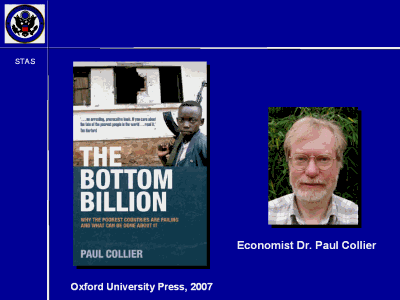| front |1 |2 |3 |4 |5 |6 |7 |8 |9 |10 |11 |12 |13 |14 |15 |16 |17 |18 |19 |20 |21 |22 |23 |24 |25 |26 |27 |28 |29 |30 |31 |32 |33 |34 |review |
 |
In his book titled “The Bottom Billion”, economist Paul Collier offers an insightful analysis of the many factors that contribute to trapping the poorest nations in continuing cycles of poverty and unrest. One of the contributing factors, of course, is the generally low educational capacity and level of the poorest nations. For many years, the U. S. has educated talented students from around the world. Today virtually every developed country realizes the value to the economy of the best and brightest students – and actively seeks to recruit them. But herein lies a paradox: sending the best students to be educated in more developed countries often further exacerbates the country’s problems because the education itself – whether it is a teacher’s certificate, a nursing degree, or a Ph.D. – makes it easier for individuals to find employment and a more stable life in a developed country. This “brain drain” has robbed – and is continuing to rob – many poor countries of their educated people. These are the people who design, develop and maintain society’s infrastructure – its agriculture, its schools, its clinics, its power and telecommunications networks. And they are the professors and researchers who generate and propagate the knowledge – the science and technology – that are essential in every aspect of life and that are the driving force of today’s successful economies. I believe that we need a deep paradigm shift in our interactions with the less developed world: from distant aid recipients to partners in building a global future. We need to bring our science, engineering and technology infrastructure and educational system to bear directly and in new ways to create a world in which all people have the opportunities now available almost exclusively in the developed world. I think this paradigm shift is getting underway – among governments, in charitable foundations, in the business world, and in the academic world. It is driven in some measure by necessity and – perhaps in some measure by the fact that modern communications media make the disparities among the nations of the world harshly and constantly apparent to everyone. I give you an example of such a driving necessity atop a persistent disparity. |